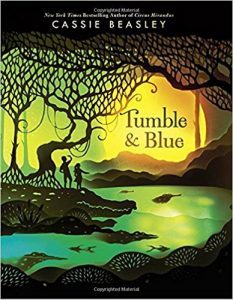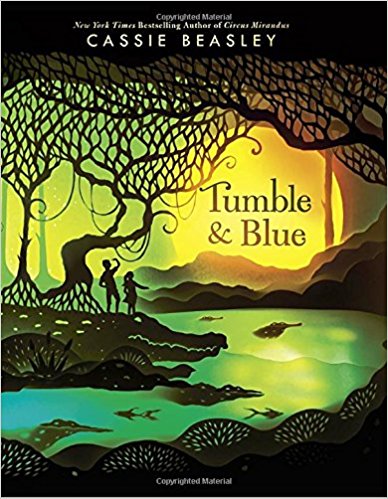craft review by Anne-Marie Strohman
 Tumble and Blue begins with a sly-talking golden alligator. The opening two pages reveal an ancient story of two people who attempted to claim a changed fate under the Red Sickle Moon. What comes next is the story of two of their descendants, the cursed-to-lose Blue Montgomery and the super-hero-obsessed Tumble Wilson. Set near and in the Okefenokee Swamp, the story follows these two friends as they attempt to change Blue’s fate.
Tumble and Blue begins with a sly-talking golden alligator. The opening two pages reveal an ancient story of two people who attempted to claim a changed fate under the Red Sickle Moon. What comes next is the story of two of their descendants, the cursed-to-lose Blue Montgomery and the super-hero-obsessed Tumble Wilson. Set near and in the Okefenokee Swamp, the story follows these two friends as they attempt to change Blue’s fate.
The story transitions between the alligator’s direct addresses to the reader and a close third person point of view, starting with Blue and including Tumble and, at the end, Tumble’s mother.
I want to examine how Beasley shifts points of view, and the effects of these shifts in telling this compelling friendship story. (Keep watch for another post on Tumble and Blue coming this spring.)
The Alligator Sections
The first pages of Tumble and Blue are framed with a woodcut of trees and swamp. The text is in the sinuous voice of the golden alligator, the one who can change a fate when the red sickle moon has risen.
“My business with mankind is not, strictly speaking, that of the predator.
I do have to remind myself of that when they come carrying maps. How they love those little guides with their safe paths through the swamp, all dotted out and color-coded. Acres of prairie and blackwater and cypress and pine captures as lines on bits of paper. Made small as gnats.
Such arrogant morsels, you humans. That’s something that hasn’t changed” (1-2).
The alligator pages appear periodically through the book, interpreting the events we are being told in the main narrative, and setting up the character to become part of the main narrative in the climactic scene.
Blue’s Story
The main narrative begins in the first chapter, titled “Blue.” It introduces Blue Montgomery as he is dropped off at his grandma’s house by his dad-who-always-wins. We see the town of Murky Branch, Georgia, through Blue’s eyes, in close third person point-of-view.
“The sounds were strange. In Atlanta, even at night, sirens and horns had screamed past the hotel where they’d been living, but here, the darkness was loud with chirring insects and frog song. Blue felt like his ears had been tuned to the wrong channel” (7).
Blue’s story continues as he meets colorful extended family members, makes a place for himself in the attic, and discovers that more folks than just him are wishing to change their fate. We are with Blue for the first five chapters–over 45 pages into the book, before . . .
Tumble Enters the Picture
In Chapter 6, titled “Tumble,” Blue meets Tumble (as do we) after yet another failed attempt to run from Granny Eve’s house to the Murky Branch sign in under twelve minutes–faster than his dad. And in this chapter, we see Tumble only from Blue’s perspective. She has heard him scream and proclaims, “I’m here to help, and help is here!” She attempts to be a hero by assessing the situation, like her hero Maximal Star would:
“‘Are you having heart trouble? . . . Abdominal pain? . . . Shin splints? . . . A stitch in your side?’ She waved a white plastic case at him, and Blue realized it was a first aid kit” (48-49).
This decision to stay in Blue’s POV to introduce Tumble makes the transition to Tumble’s point of view seamless. At the end of the chapter, Beasley leads us straight into the next chapter, one from Tumble’s point of view. Here’s the last four paragraphs of Chapter 6, in Blue’s point of view, and the first few of Chapter 7, where we shift to Tumble’s.
“‘I’m Tumble Wilson,” Tumble said, reaching out for a handshake. ‘Nice to meet you.’
Blue grasped her hand with fingers that felt so clumsy he might as well have been wearing mittens.
‘You’re normal,’ he said weakly.
Tumble pistoned his hand up and down. ‘I prefer,’ she said, ‘to think of myself as potentially extraordinary.’Seven: How to Hero Every Day
The Wilson family’s RV should have been filled with morning sounds when Tumble made it back home. The coffeepot gurgling in the kitchen area, the tiny shower hissing, and maybe Tumble’s dad singing one of his jingles while he washed his hair.
Right now he was writing one for a company that made coconut shampoo. They’d sent so many free samples that the family had been using it to clean everything from their socks to the RV’s tires.
Tumble set her first aid kit on the foot of her sofa bed and flopped down on top of her fuzzy blue blanet. Then she closed her eyes and sniffed the air. The RV smelled exactly right. Like a suscreen factory had exploded all over the place (53-54).
By ending Chapter 6 with Tumble’s speech, Beasley deftly puts us in the frame of mind to follow Tumble.
Action: When trading points of view, consider the transition carefully. Can you lead your readers into the transition so it’s nearly seamless?
How to Share–Balancing Two POVs
Tumble and Blue does not follow the traditional shared narrative structure where each character gets a chapter one right after the other. The characters tell their parts of the story. And even though the characters are mostly together after Chapter 6, the point of view shifts at irregular intervals. Our Middle Grade Lunch Break group was lucky enough to have Cassie Beasley video chat in for our in-person meeting to discuss Tumble and Blue. She shared that she decided which point of view to use based on which character the content of the chapter was most important to.
Action: Consider changing point of view when the narrative content naturally connects more to one POV character than the other.
The Climax, Or Quick Shifting Between POVs
Beasley makes one exception to her strategy of giving one or more chapters in a row to each point-of-view character: the climactic scene. When Tumble and Blue take a semi-magical journey through the Okefenokee swamp to the island of the golden alligator during the red sickle moon, the narrative becomes both of their stories together. Beasley reflects this by shifting point of view quickly between the two characters. She shared with us that she wanted the narrative to have immediacy for both characters; she didn’t want to tell the climax from one point of view and then retell it from the other. Her choice is compelling and effective, partly because the POV shifts are quick and clear.
Chapter 45, “Underwater,” begins the transition to the shared narrative. The first half of the chapter follows Blue on their approach to the island. The second half shifts to Tumble’s point of view. Chapter 46, “Meeting,” shifts more quickly, but still keeps complete scenes in each character’s point of view–it starts with Blue, shifts to Tumble, and shifts back to Blue.
The story moves back into Blue’s POV for Chapter 47, and to the alligator’s POV for his three page commentary. Finally, Beasley moves into quick-shifting points of view in Chapter 48, “Choice”:
“[Blue] just had to accept losing one more time, so that he could lose every time until he died. He squeezed his eyes shut.
‘Tumble,’ he said, dragging her name out from between his teeth. ‘You should–’
‘Shut up!’ she said, her own voice choked. ‘You shut your mouth right now!’
Tumble wanted to scream. She knew who deserved a great fate, and it wasn’t her” (359-360).
Notice that the shift in point of view occurs just after Tumble’s speech. Beasley leads us from Blue’s point of view to Tumble’s during the dialogue.
The effect of these quick shifts in point of view is to make the story belong to both characters at once. Their emotional arcs come together in this moment–both are faced with the choice to change their fate and leave the other disappointed, or sacrifice their wish for a new fate in order to care for their friend. Because the narrative shifts between their perspectives, we can see the internal struggle of each character as they attempt to make the best choice.
Action: Consider using quick point of view shifts in the climactic chapter–but only if your two protagonists carry equal weight and their emotional arcs come together in the climactic scene, and be sure to transition fluidly.
The POV Choices Should Be Dictated by the Story
As tempting as it is to stick to the tried-and-true strategy of shifting points of view chapter by chapter, consider letting the story dictate which point of view each chapter takes on. Think about what each chapter reveals to us about the characters–which character does it reveal more about? Which character has higher stakes in the chapter?
When executed well, the technique of dual, or even multiple, points of view can be effective for character development, pacing, and story. Tumble and Blue provides a masterful example of its power.
Anne-Marie Strohman (co-editor) writes picture books, middle grade novels, and young adult short stories and novels. She is trained as a teacher, an editor, and a scholar, specializing in Renaissance Literature. She holds an MFA in Writing for Children and Young Adults from Vermont College of Fine Arts and is an active member of SCBWI. Find her at amstrohman.com and on Twitter @amstrwriter.

Wow. This is a great analysis of a delightful sounding book. I love magical realism and how it’s becoming more prevalent in contemporary books. I’ve written a middle grade fiction book, Guardian Cats and the Lost Books of Alexandria, and currently working on Contemporary Women’s fiction with magical realism elements to it.
Hi Rahma,
I’m glad the post was helpful! I love the magical elements in contemporary fiction as well. Cassie Beasley’s Circus Mirandus is another one of my favorites.
[…] R.J. Palacio’s Wonder for this strategy, or Cassie Beasley’s Tumble and Blue as I’ve explored here), or through careful mid-chapter […]
[…] So, do excellent first chapters really contain important clues and elements for the whole book? Let’s look at the first chapter of Cassie Beasley’s Tumble and Blue as an example. (See our craft review on multiple points of view in Tumble and Blue here.) […]